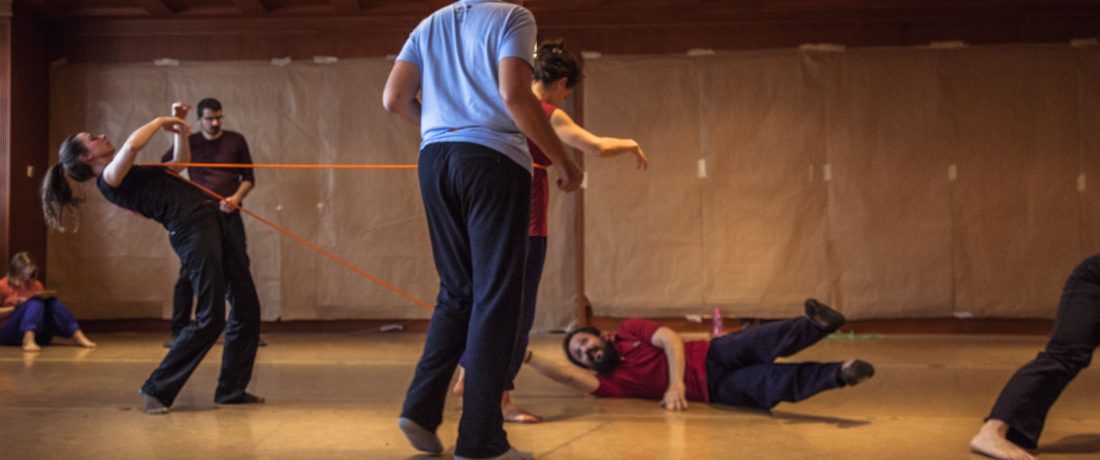
Space
3rd course for solo choreography
TARGET GROUP
adults with and without mobility impairmentsPARTICIPANTS
16DURATION
2 HoursORGANIZATION
Onassis StegiGoal - Essential question
This workshop is based choreographic research. Through improvisation we investigate: choreographic devices and composition skills, choices and decision making in dance, quality of movement, repetition, accumulation and spatial organization. The aim is the exploration of solo work, however duo, trio, quartet and group work will take place and will lead to new creation/compositions and performance.
Objectives
A solo choreographic work will be investigated and developed within the group. Choreography as an art form can offer a sense of achievement and success. Since the workshops are attended by a group of people coming from different backgrounds in movement and dance, the main idea is to give the opportunity to each one of them to deepen their own work.
For beginners, that this is their first participation in an inclusive movement workshop, the research will be based on the creation of a movement phrase. In the case of more advanced students that have a stronger background (participating the last three years in the workshops, following a dance study curriculum etc) the goal will be towards the realization of a complete idea leading to their own unique creation.
The focus is on the study of movement and the presence of the performer.
A solo choreography can be a challenge for practice based research work beyond our regular weekly meetings. Moreover through this approach we believe that the work can become more responsive, attentive and flexible to each individuals needs and as a result the workshops are effective and fully inclusive.
Examples will be given of the way the workshops are planned. These are indicative of this kind of process where the focus is on a creative approach and not a technically based class.
To quote M. Tufnell and C. Crickmay:
any creative process is to this extent improvised and involves states of not knowing what comes next .
Improvisation is used mostly during these workshops as a means to explore movement material, to train our perception and kinaesthetic awareness in order to develop solo work but also to develop group relationships. ‘Improvisation provides us with a means to excavating layers of experience, sensation, character, feeling that we normally rush through or suppress – to travel deeper and deeper into an ever enlarging and changing moment…As a strategy for discovering and developing images it both demands and creates a whole range of skills, the most important of which is an ability to be still and open one’s attention to the present moment’ . Moreover chorographical concepts are being introduced and explored.
Through the course of our 12 encounters, our main interest is in how dance can provide the means, through which we can gain confidence through movement, can challenge ourselves and further develop our knowledge both individually and as a group.
Materials
puzzle mats, headphones, pillows, mattresses, scratches, wheelchairs, chairs, smartphones, I-pods, tapes, ropes, stairs, corridors, 4th floor foyer of Onassis cultural centre.
Introduction| Space in the body / body in the space (10 minutes)
What do we mean with the above mentioned terms? Think tank / questions / thoughts.
So far we have worked more with the space in the body during our warming up exercises. We will now approach the body in its personal space and then in the whole working space.
1st activity | The Body and its personal space / solo work (30 minutes)
Exploring the body movements within its kinesphere, the personal space, which is the space surrounding the body. The space under, in between, on top, behind, left, right, the negative space, in between two or more body parts. Observing proximity and distance of body aspects with each other and with the general space like the floor, the ceiling, the earth, the sky, the surrounding walls, objects and people, we gain spatial awareness.
Demonstration (5 minutes)
Questions / Discussion / (5-10 minutes)
Feedback on how the fore mentioned task was understood and how we can possibly extend the work further.
2nd Activity | Group work / body in space (40 minutes)
Constantly shifting between solo and group work is challenging for the individual and the group. Group work allows all participants to have equal roles in a creative way.
This group improvisation sharpens the perception with its simultaneous act of being able to observe and to perform at the same time. Each participant chooses a starting point A on the periphery of the room and a pre-decided final destination B. The group is equally distributed on the periphery of the room. At any time anyone can start walking/crossing the space with a clear intention towards a specific arrival point. The departure and arrival points must be always on the periphery. The crossings are linear in pathway with simple walking patterns. Everyone is observing and being observed trying to have an overall view of the whole space and the ‘traffic’ within it. Walking patterns can be forwards or backwards in direction, slow or fast in rhythm, with or without interruptions in flow. This task can also allow for different patterns to evolve by surprising our self and the others and allowing different rhythms to manifest as the group gains confidence.
Group improvisation demands on opening of the attention, both to the work space and to the corpus of people in the space, as an ever changing pattern of sound, activity, colour and energy.
